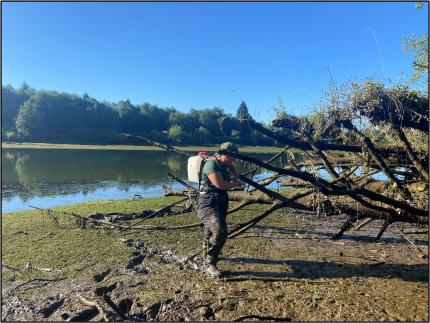Providing Conflict Prevention and Education
Injured Owl: Biologist Wickhem and Volunteer Downing responded to a report of an injured great-horned owl near BZ Corners in Klickitat County. The owl had been seen perched on private property with what appeared to be a broken wing. The pair found the owl tucked underneath several stacked pieces of thick, metal trailer decking. Volunteer Downing was able to gently coax the owl out from under the decking with a long stick and Wickhem easily captured the tired bird as it emerged. The owl was taken to Rowena Wildlife Clinic for assessment. Unfortunately, the veterinarian said the break was more than a week old and too much bone was exposed for the wing to heal properly, so she decided to euthanize the owl to spare it from any further discomfort.


Agricultural Damage: Wildlife Conflict Specialist Aubrey met with landowners throughout District 10 experiencing damage to agriculture from deer and elk. Damage prevention cooperative agreements were drafted and signed.
Possible Cougar Sighting: Wildlife Conflict Specialist Aubrey placed a trail camera at a residence to monitor a potential cougar sighting.
Conserving Natural Landscapes
Mowing at Shillapoo Wildlife Area. In preparation for fall and the arrival of migratory waterfowl, large scale mowing activities have begun at the Shillapoo Wildlife Area. The mowing of tall, mature grasses encourages new growth, providing excellent forage for the geese, ducks, and sandhill cranes that will begin arriving later this fall. In some areas such as Vancouver Lake, the mowing is done in phases to provide temporary habitat and cover for pheasants that are released by WDFW for hunting opportunities at Shillapoo Wildlife Area.

Shillapoo and Mt. St. Helens Wildlife Area: Purple loosestrife is arguably one of the prettiest weeds growing on WDFW lands, and it is also on the priority list of noxious weeds treated by wildlife area staff members. Well known to people in other parts of the county where purple loosestrife has taken over vast amounts of shoreline, purple loosestrife often goes under the radar here in western Washington. It is often overlooked as just an attractive wetland plant with purple flowers. Through the months of July and August, Shillapoo and Mt. St. Helens wildlife area personnel visited and revisited many purple loosestrife sites to ensure this noxious weed is controlled effectively and its spread is prevented.

